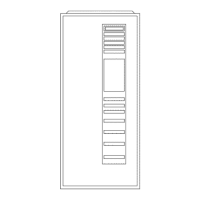Table 12--Gas Rate (Cu Ft/Hr)
SECONDS
FOR I
REVOLUTION
10
11
12
13
14
15
16
17
18
19
2O
21
22
23
24
25
26
27
28
29
30
81
32
33
34
35
86
87
88
39
40
41
42
43
44
45
46
47
48
49
SiZE OF TEST DiAL SECONDS SiZE OF TEST DiAL
1 8 5 FOR 1 1 8 5
cu fl cu fl cuff REVOLUTION cuff cu fl cu fl
360 720 1800 50 72 144 360
327 655 1636 61 71 141 355
300 600 1500 62 69 138 346
277 555 1385 63 68 136 340
257 514 1286 64 67 133 333
240 480 1200 58 65 131 327
225 450 1125 58 64 129 321
212 424 1059 67 63 126 316
200 400 1000 68 62 124 310
189 379 947 69 61 122 305
180 360 900 60 60 120 300
171 343 857 82 58 116 290
164 327 818 84 56 112 281
157 313 783 66 54 109 273
150 300 750 88 53 106 265
144 288 720 78 51 103 257
138 277 692 72 50 100 250
133 267 667 74 48 97 243
129 257 643 76 47 95 237
124 248 621 78 46 92 231
120 240 600 80 45 90 225
116 232 581 82 44 88 220
113 225 563 84 43 86 214
109 218 545 86 42 84 209
106 212 529 88 41 82 205
103 206 514 80 40 80 200
100 200 500 82 39 78 196
97 195 486 94 38 76 192
95 189 474 96 38 75 188
92 185 462 98 37 74 184
90 180 450 100 36 72 180
88 176 439 102 35 71 178
86 172 429 104 35 69 173
84 167 419 108 34 68 170
82 164 409 108 33 67 167
80 160 400 110 33 65 164
78 157 391 112 32 64 161
76 153 383 118 31 62 155
75 150 375 120 30 60 150
73 147 367 124 29 88 145
EXAMPLE: (0 2000 fi altitude)
Furnace input t'rom rating plate is 100,000 Bmh
Btu heating input Btuicu t:i X cu ft&r
Heating value of gas 975 Bmicu ft
Time for 1 revolution of 2=cu t_ dial 70 sec
Gas rate 103 cu ftihr (t'rom Table 12)
Btu heating input 103 X 975 100,425 Bmh
In this example, the orifice size and manifbld pressure
adjustment is within _+2percent of the fm'nace input rate.
SET TEMPERATURE RISE
• ._ . _j,
{NIT DAMAGE HAZARD
Failure to %llow this caution may result in overheating the
heat exchangers or condensing flue gases in heat exchanger
areas not designed t'or condensate.
Temperature rise must be within limits specified on unit
rating plate. Recommended operation is at mi@oint of rise
range or slightly above.
Determine and adjtmt air temperature rise as fbllows:
1. Place thermometers in return and supply ducts as close to
fm'nace as possible. Be sure them_ometers do not see heat
exchanger so that radiant heat does not af?:'_ct readings. This
practice is particularly important with stlaight=run ducts.
2. When thermometer readings stabilize, subtract return-air tern=
peramre t'rom supply=air temperature to determine air tern=
perature rise.
3. Adjust temperature rise by adjusting blower speed. Increase
blower speed to reduce temperature rise Decrease blower
speed to increase temperature rise
ELECTRICAL SHOCK HAZARD
Failure to fbllow this warning could result in personal injury
or death.
Disconnect 115=v electrical power before changing speed tap
4. To change blower motor speed selections %r heating mode,
remove blower motor lead from control center HEAT termi=
hal. (See Fig 3!) Select desired blower motor speed lead
fi'om 1 of the other motor leads and relocate it to HEAT
terminal See Table 13 for lead color identification. Reconnect
original lead on SPARE terminal.
Follow d_is same procedure fbr proper selection of COOL
speed selection
Table 13--Speed Selector
FACTORY-
COLOR SPEED SHPPBD
CONNBCTION
B_ack High Cool
Yellow (When Present) Medium High Spare
Blue Medium Low Heat
Red Low Spare
White Common Corn
46
ADJUST BLOWER OFF DELAY (HEAT MODE)
The blower offdelay has 4 adjustable settings t'rom 90 sec to 180
sec. (See Table 14.) The blower off delay jumpers are located on
the famace control board (see Fig. 31). To change the blower off
delay setdng, move the jumper fi'om one set of pins on the contlol
board to the pins used for d-_e desired blower off delay. Factow
blower off delay setting is 120 sec.
Table 14_BIower Off Delay Setup Position
PiNS 1AND2 2AN[:)3 3AN[:)4 [ 4AND 5
Time (in sec) 90 120 150 _ 180
SET THERMOSTAT HEAT ANTICIPATOR
When using a nonelectronic thermostat, d_e thermostat heat
anticipator must be set to match the amp &aw of d-_e electrical
components in R=W circuit. Accurate amp draw readings can be
obtained at thermostat subbase terminals R and W. Fig 53
illustrates the easy method of obtaining actual amp &aw. The amp
reading should be taken after blower motor has started and furnace
is heating. Connect ammeter wires as shown in Fig. 53. The
themlostat anticipator should NOT be in the curcuit while mea-
suring current. If thermostat has no subbase, the thermostat must
be disconnected t'rom R and W wires during cmTent measurement.
See thermostat manufhcmrer's instructions for adjusting heat
anticipator and for varying heating cycle length.
For an electronic thermostat, set cycle rate for 3 cycles per hour.
Step 6--Cheek Safety Controls
This section covers the safety contlols that must be checked befbre
the installation is complete. The flame sensor, gas valve, and
pressure switch were all checked in the Start=up procedure section
as part of normal operation.

